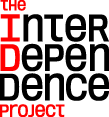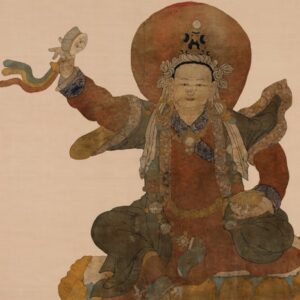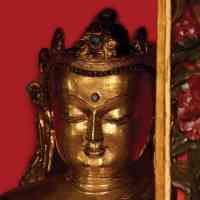
ABOUT THE MEDITATION
Meditation session led by Gyetrul Jigme Rinpoche.
The guided meditation begins at 15:57.
For centuries Himalayan practitioners have used meditation to quiet the mind, open the heart, calm the nervous system, and increase focus. Now Western scientists, business leaders, and the secular world have embraced meditation as a vital tool for brain health.
Whether you’re a beginner, a dabbler, or a skilled meditator seeking the company of others, join expert teachers in a forty-five-minute weekly program designed to fit into your lunch break. Each session will be inspired by a different work of art from the Rubin Museum’s collection and will include an opening talk, a twenty-minute meditation session, and a closing discussion.
This program is presented in partnership with Sharon Salzberg, the Interdependence Project, and Parabola Magazine and supported by the Frederick P. Lenz Foundation for American Buddhism.

Related Artwork

THEME: ACCEPTANCE
This figure richly attired in royal garb, playing a hand drum and holding a skull cup, represents a manifestation of the legendary wizard and founding saint of Tibetan Buddhism, Padmasambhava, called Loden Choke. Padmasambhava’s life was said to be full of magical battles and teaching activities in India and across the Himalayas, which earned him many names by which he became known. These names assumed specific iconographic forms that are thought to represent his various aspects. Loden Choke represents the (lay-tantric) scholar manifestation of Padmasambhava.
Although of substantial size itself, this is only a detail of what was once a huge, impressive appliqué depicting the Buddhist master surrounded by all eight of his manifestations. Such large appliqué images are made of scraps of multicolored silks in various patterns that are cut to shape, cleverly integrated into a complex rendering, and sewn into gigantic compositions. These huge textiles are displayed at annual celebrations for communal viewing on the outside wall of a monastery or the side of a hill. They are found all over the Tibetan Buddhist world and are especially popular in Tibetan, Bhutanese, and Mongolian regions.
ABOUT THE SPEAKER

His Eminence Gyetrul Jigme Rinpoche is the son of the renowned terton, or “treasure revealer,” Namkha Drimed Rabjam Rinpoche, holder of the Ripa lineage. As a socially engaged Buddhist, philanthropic projects are a central part of his life’s work. Born in India, he has firsthand experience of the plight of Tibetan refugees and local villagers in finding and retrieving potable water. This inspired him to found the Pure Water Project, for which he received a citation from the Dalai Lama and the Tibetan Government in Exile. Other projects he directs include creating a malaria prevention and treatment program and the support of orphans, schoolchildren, monks, and the elderly. Jigme Rinpoche oversees the Ripa monasteries in both Nepal and India, along with their growing monastic communities and the Tibetan community in exile. He continues his teachings through Padma Ling and the Ripa Ladrang Foundations.

